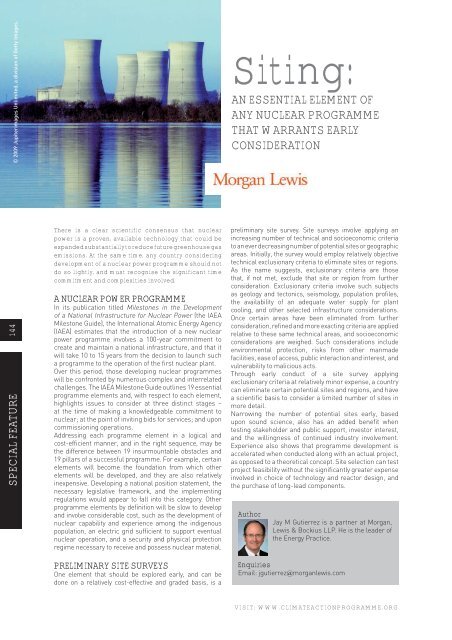Climate Action 2009-2010
Create successful ePaper yourself
Turn your PDF publications into a flip-book with our unique Google optimized e-Paper software.
© <strong>2009</strong> Jupiterimages Unlimited, a division of Getty Images.<br />
Siting:<br />
AN ESSENTIAL ELEMENT OF<br />
ANY NUCLEAR PROGRAMME<br />
THAT WARRANTS EARLY<br />
CONSIDERATION<br />
SPECIAL FEATURE 144<br />
There is a clear scientific consensus that nuclear<br />
power is a proven, available technology that could be<br />
expanded substantially to reduce future greenhouse gas<br />
emissions. At the same time, any country considering<br />
development of a nuclear power programme should not<br />
do so lightly, and must recognise the significant time<br />
commitment and complexities involved.<br />
A NUCLEAR POWER PROGRAMME<br />
In its publication titled Milestones in the Development<br />
of a National Infrastructure for Nuclear Power (the IAEA<br />
Milestone Guide), the International Atomic Energy Agency<br />
(IAEA) estimates that the introduction of a new nuclear<br />
power programme involves a 100-year commitment to<br />
create and maintain a national infrastructure, and that it<br />
will take 10 to 15 years from the decision to launch such<br />
a programme to the operation of the first nuclear plant.<br />
Over this period, those developing nuclear programmes<br />
will be confronted by numerous complex and interrelated<br />
challenges. The IAEA Milestone Guide outlines 19 essential<br />
programme elements and, with respect to each element,<br />
highlights issues to consider at three distinct stages –<br />
at the time of making a knowledgeable commitment to<br />
nuclear; at the point of inviting bids for services; and upon<br />
commissioning operations.<br />
Addressing each programme element in a logical and<br />
cost-efficient manner, and in the right sequence, may be<br />
the difference between 19 insurmountable obstacles and<br />
19 pillars of a successful programme. For example, certain<br />
elements will become the foundation from which other<br />
elements will be developed, and they are also relatively<br />
inexpensive. Developing a national position statement, the<br />
necessary legislative framework, and the implementing<br />
regulations would appear to fall into this category. Other<br />
programme elements by definition will be slow to develop<br />
and involve considerable cost, such as the development of<br />
nuclear capability and experience among the indigenous<br />
population, an electric grid sufficient to support eventual<br />
nuclear operation, and a security and physical protection<br />
regime necessary to receive and possess nuclear material.<br />
PRELIMINARY SITE SURVEYS<br />
One element that should be explored early, and can be<br />
done on a relatively cost-effective and graded basis, is a<br />
preliminary site survey. Site surveys involve applying an<br />
increasing number of technical and socioeconomic criteria<br />
to an ever decreasing number of potential sites or geographic<br />
areas. Initially, the survey would employ relatively objective<br />
technical exclusionary criteria to eliminate sites or regions.<br />
As the name suggests, exclusionary criteria are those<br />
that, if not met, exclude that site or region from further<br />
consideration. Exclusionary criteria involve such subjects<br />
as geology and tectonics, seismology, population profiles,<br />
the availability of an adequate water supply for plant<br />
cooling, and other selected infrastructure considerations.<br />
Once certain areas have been eliminated from further<br />
consideration, refined and more exacting criteria are applied<br />
relative to these same technical areas, and socioeconomic<br />
considerations are weighed. Such considerations include<br />
environmental protection, risks from other manmade<br />
facilities, ease of access, public interaction and interest, and<br />
vulnerability to malicious acts.<br />
Through early conduct of a site survey applying<br />
exclusionary criteria at relatively minor expense, a country<br />
can eliminate certain potential sites and regions, and have<br />
a scientific basis to consider a limited number of sites in<br />
more detail.<br />
Narrowing the number of potential sites early, based<br />
upon sound science, also has an added benefit when<br />
testing stakeholder and public support, investor interest,<br />
and the willingness of continued industry involvement.<br />
Experience also shows that programme development is<br />
accelerated when conducted along with an actual project,<br />
as opposed to a theoretical concept. Site selection can test<br />
project feasibility without the significantly greater expense<br />
involved in choice of technology and reactor design, and<br />
the purchase of long-lead components.<br />
Author<br />
Jay M Gutierrez is a partner at Morgan,<br />
Lewis & Bockius LLP. He is the leader of<br />
the Energy Practice.<br />
Enquiries<br />
Email: jgutierrez@morganlewis.com<br />
VISIT: WWW.CLIMATEACTIONPROGRAMME.ORG












